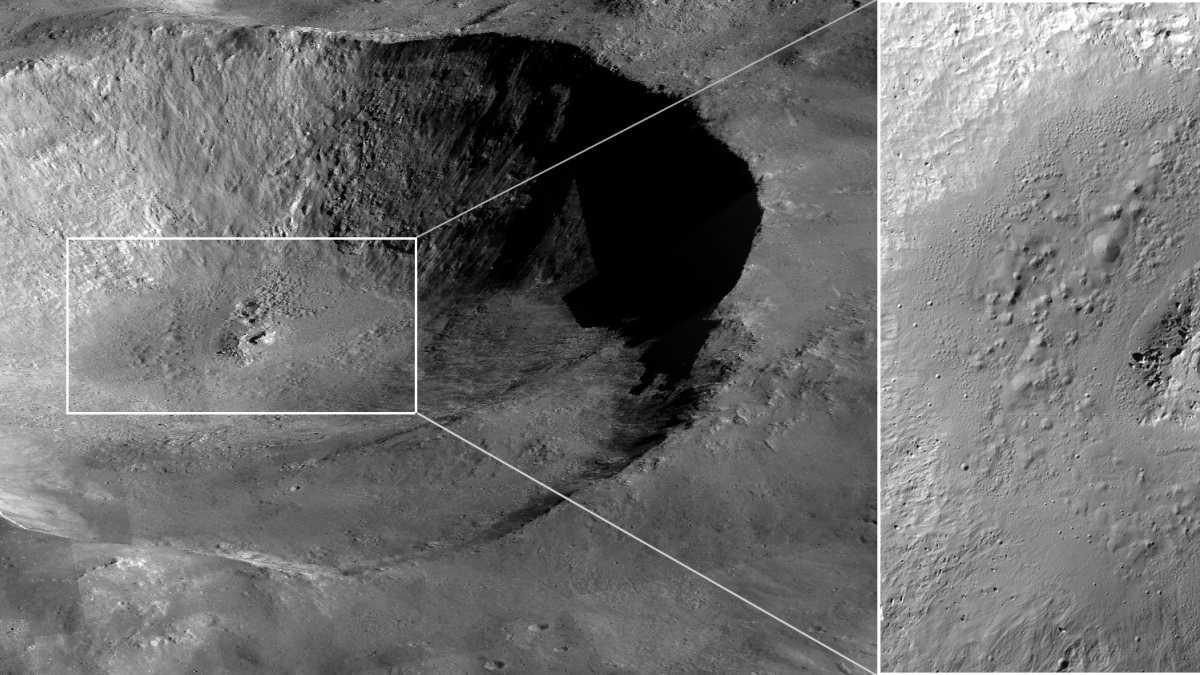Researcher helps investigate volatiles on asteroid Vesta

The giant asteroid Vesta, it turns out, has its own version of ring around the collar. Two new papers based on observations from the low-altitude mapping orbit of NASA’s Dawn mission reveal that volatile materials have colored Vesta’s surface in a broad swath around its equator. Pothole-like features mark some of Vesta’s surface when the volatiles, likely water, released from hydrated minerals boiled off. The findings were released today in the journal Science.
Dawn did not find actual water ice at Vesta, but signs of hydrated minerals delivered by meteorites and dust are evident in the giant asteroid’s chemistry and geology. One paper, led by Thomas Prettyman, the lead scientist for Dawn’s gamma ray and neutron detector (GRaND) at the Planetary Science Institute in Tucson, Ariz., describes how the instrument found signatures of hydrogen, likely in the form of hydroxyl or water bound to minerals in Vesta’s surface. A complementary paper, led by Brett Denevi, a Dawn participating scientist based at the Johns Hopkins University Applied Physics Laboratory in Laurel, Md., describes the presence of pitted terrain created by the outgassing of volatiles.
David A. Williams, an associate research professor in the School of Earth and Space Exploration in ASU's College of LIberal Arts and Sciences, is a participating scientist on the Dawn mission and contributed to the Denevi study.
Upon finding signs of hydrated minerals, the scientists set out to find out where the hydrogen within Vesta’s surface came from. It turns out that hydrated minerals appear to be delivered by carbon-rich space rocks that collided with Vesta at speeds slow enough to preserve their volatile content.
Scientists thought it might be possible for water ice to survive near the surface around the giant asteroid’s poles. But, unlike the Moon, Vesta has no permanently shadowed polar regions where ice might survive. And the strongest signature for hydrogen in the latest data came from regions near the equator, where water ice is not stable.
In some cases, other space rocks crashed into these deposits later at high speed. The heat from the collisions converted the hydrogen bound to the minerals to water, which evaporated. The holes that were left as the water escaped stretch as much as 0.6 miles (1 kilometer) across and go down as deep as 700 feet (200 meters). Seen in images from Dawn’s framing camera, this pitted terrain is the most spectacularly preserved in sections of Marcia crater.
“When we first saw the pitted terrain in Dawn images, many on the science team thought immediately that this was evidence for the release of volatiles from the surface,” said Denevi. “The pits look just like features seen on Mars, but while water [was] common on Mars, it was totally unexpected on Vesta in these high abundances. The results provide evidence that not only were hydrated materials present, they played an important role in shaping the asteroid’s geology and the surface we see today.”
“I am tasked with the geologic mapping of Marcia crater region, and I was amazed when we saw these pitted terrains on the crater floor,” said Williams. “When you place images of this terrain side by side with images of similar terrain on Mars, it is clear why we think release of volatiles, perhaps water ice, could explain this unusual vestan terrain.”
Williams worked with Denevi and others on the Dawn team to analyze the pitted terrain on Vesta, and compare it with similar features recently identified in high resolution images of Mars. After exploring various hypotheses that might explain the terrain, the leading hypothesis became the release of volatiles during the formation of the Marcia crater.
“The key unresolved question, was the volatile material, presumably water ice, in Vesta’s crust itself when the impact occurred, or was brought in by the impactor that formed Marcia crater? Further research may resolve this question,” said Williams.
Vesta is the second most massive member of the main asteroid belt. The orbit at which these data were obtained averaged about 130 miles (210 kilometers) above the surface.
GRaND’s data are the first direct measurements describing the elemental composition of Vesta’s surface. Dawn’s elemental investigation by the instrument determined the ratios of iron to oxygen and iron to silicon in the surface materials. These findings solidly confirm the connection between Vesta and a class of meteorites found on Earth called the Howardite, Eucrite and Diogenite (HED) meteorites, which have the same ratios for these elements. In addition, more volatile-rich fragments of other objects have been identified in HED meteorites, which supports the interpretation that the materials were deposited externally on Vesta.
“Working on the Dawn mission at Vesta has been very exciting,” said Williams. “Vesta is more than just a space rock; it is a protoplanet and shows evidence of geologic processes we see on the larger planets of the Solar System.”
Dawn left Vesta on Sept. 4, 2012 PDT (Sept. 5, 2012 EDT) and is now on its way to its second target, the dwarf planet Ceres.